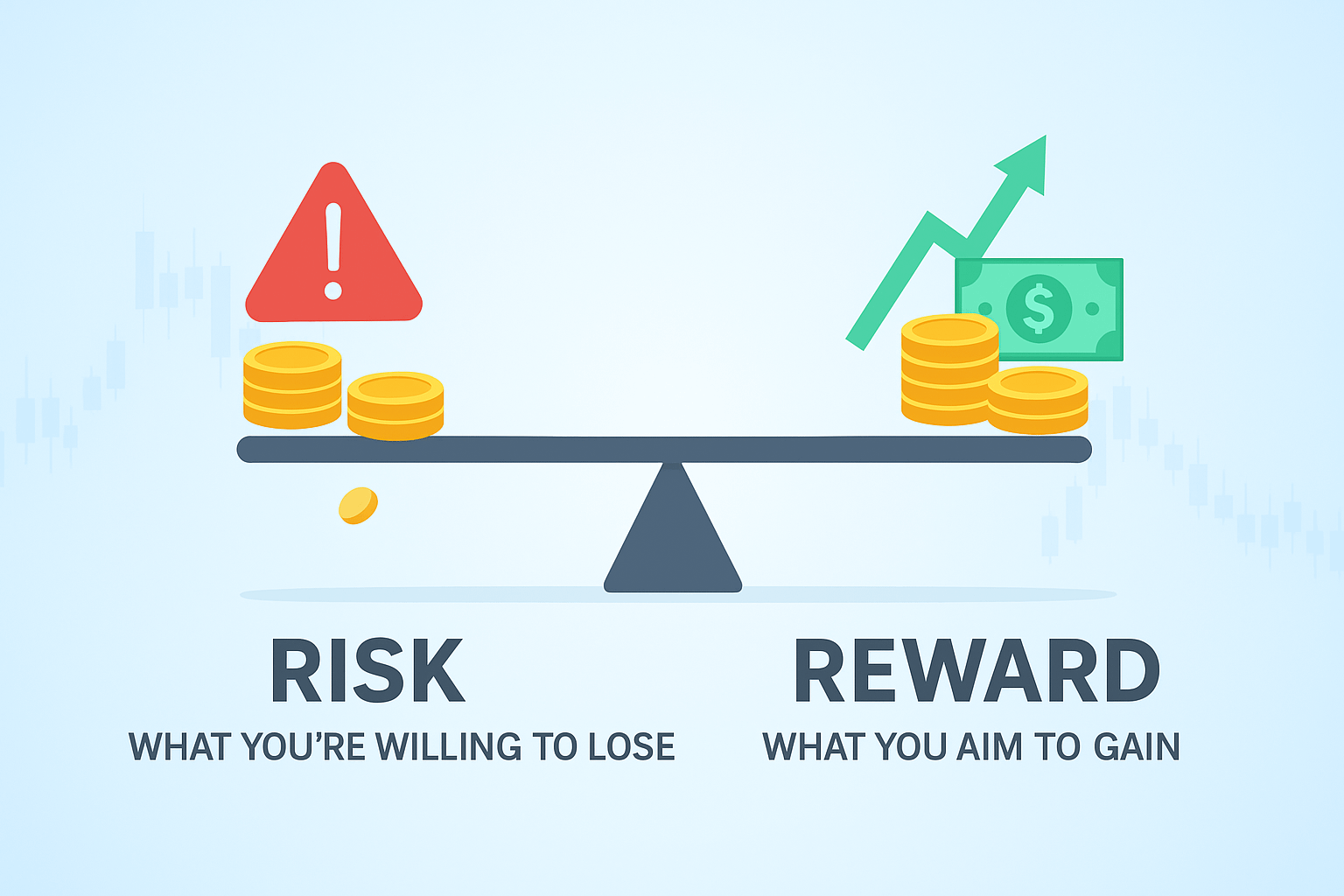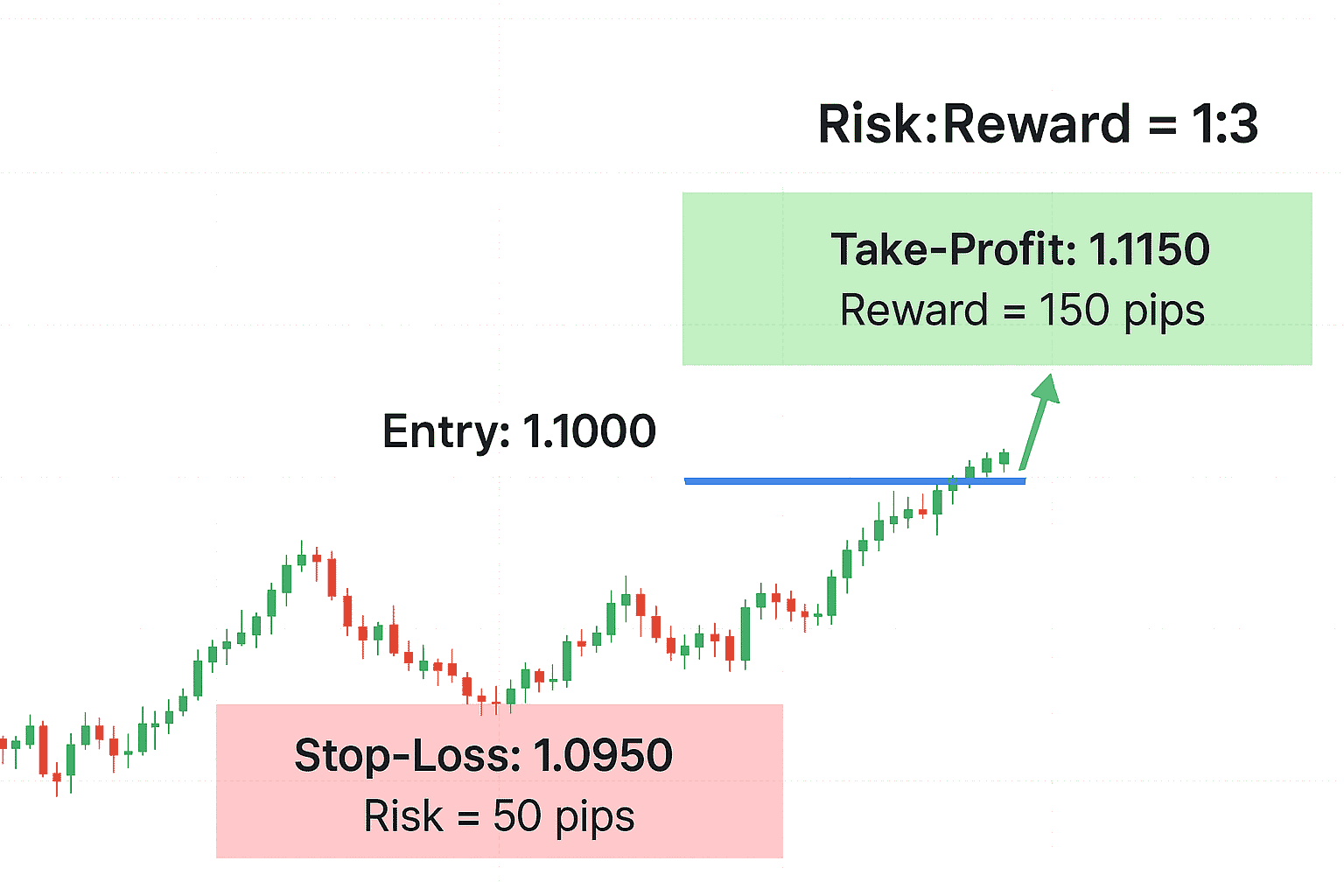Risk vs Reward in Forex: A Simple, Smart Guide
Aug 18
Imagine you have $10 and you're willing to risk $2 to try and make $6. That's the basic idea of risk and reward. In forex trading, you always have two sides to every trade: how much you could lose (the risk) and how much you hope to gain (the reward). A smart trader knows how to balance both.
You don’t need to win every trade. What matters more is how much you make when you win, and how little you lose when you don’t. This is why understanding the risk vs reward concept is a big part of becoming a good forex trader.
In this guide, we’ll break down everything you need to know about risk and reward in forex trading. We’ll show you how to calculate your risk reward ratio, why it matters, and how to use it to protect your money and grow your trading skills over time.
You don’t need to win every trade. What matters more is how much you make when you win, and how little you lose when you don’t. This is why understanding the risk vs reward concept is a big part of becoming a good forex trader.
In this guide, we’ll break down everything you need to know about risk and reward in forex trading. We’ll show you how to calculate your risk reward ratio, why it matters, and how to use it to protect your money and grow your trading skills over time.
What's Risk, and What's Reward?
Before we get to the main idea, let’s quickly talk about what risk and reward are by themselves.
What is Risk? 📉
In trading, risk is the amount of money you could lose on a single trade. It's the maximum amount you are okay with losing if a trade doesn't go your way. Before you ever hit the "buy" or "sell" button, you should have a clear number in your mind. This is your safety net.
Think of it like this: If you are trading, you decide ahead of time, "I am only willing to lose $20 on this trade." That $20 is your risk. You manage this by using a special tool called a "stop loss." A stop loss is an automatic order that closes your trade for you if the price moves against you and hits your pre-set limit. This is how you protect your money from big losses. It’s like putting a fence around your money to keep it safe.
Think of it like this: If you are trading, you decide ahead of time, "I am only willing to lose $20 on this trade." That $20 is your risk. You manage this by using a special tool called a "stop loss." A stop loss is an automatic order that closes your trade for you if the price moves against you and hits your pre-set limit. This is how you protect your money from big losses. It’s like putting a fence around your money to keep it safe.
What is Reward? 💰
The reward is the opposite of risk. It’s the amount of money you hope to make if your trade is successful. This is your profit goal. You might say, "I want to make $60 on this trade." That $60 is your reward.
Just like with risk, there is a tool to help you here too. It's called a "take profit" order. This is another automatic order that closes your trade for you when the price reaches your profit goal. It helps you lock in your gains without having to watch the market all day long. This lets you stick to your plan and not get greedy or scared.
Just like with risk, there is a tool to help you here too. It's called a "take profit" order. This is another automatic order that closes your trade for you when the price reaches your profit goal. It helps you lock in your gains without having to watch the market all day long. This lets you stick to your plan and not get greedy or scared.

What Is the Risk Reward Ratio?
The risk reward ratio shows how much you're risking compared to how much you could gain. It's usually written like this: 1:2 or 1:3. This means for every $1 you risk, you're trying to make $2 or $3.
Let’s look at a simple example. If you enter a trade and you’re risking $10 to possibly earn $30, your risk reward ratio is 1:3. You’re putting $10 at risk in hopes of getting three times that amount.
Let’s look at a simple example. If you enter a trade and you’re risking $10 to possibly earn $30, your risk reward ratio is 1:3. You’re putting $10 at risk in hopes of getting three times that amount.
Why It Matters
A good risk reward ratio helps you:
In short, your ratio helps you focus on the bigger picture. It helps you build a strategy that works over many trades, not just one.
- Trade with a plan, not on emotion
- Stay calm even when you lose
- Win more money over time, even with fewer winning trades
In short, your ratio helps you focus on the bigger picture. It helps you build a strategy that works over many trades, not just one.
How to Calculate the Risk Reward Ratio
Calculating your risk and reward ratio is a key step to becoming a smart trader. It’s a simple process that anyone can follow. Think of it as mapping out your trade before you take it.
Here’s how you do it, broken down into simple steps:
Here’s how you do it, broken down into simple steps:
1. Choose Your Starting Point (Entry Price)
This is the exact price where you plan to enter the market. It’s where your trade will begin. You should have a reason for choosing this price based on your plan.
2. Set Your Loss Limit (Stop-Loss)
This is the price you decide you will exit the trade if things go wrong. It’s your safety net. You need to put your stop-loss at a logical place on the chart, where you would know for sure that your idea about the trade was incorrect.
3. Set Your Profit Goal (Take-Profit)
This is the price where you will exit the trade if it goes your way. It's your finish line! Just like your stop-loss, you should place your take-profit at a logical spot on the chart where it makes sense to lock in your profit.
4. Do the Simple Math!
Now that you have your three prices, you can find the distance between them. In forex, we often talk about distance in "pips." A pip is a small price movement, like a penny is a small movement for a dollar.
Then, you just do the easy math: you divide your Reward by your Risk. The number you get is your risk reward ratio.
Example: Imagine a trade where you set your prices like this:
Now, let's find the ratio:
Reward (60 pips) / Risk (30 pips) = 2
This means your ratio is 2, or as we write it, 1:2. It's a great setup! You are risking 1 unit of money to potentially win 2 units of money. This simple calculation gives you the confidence to know that the trade is a smart choice before you even begin.
- Your Risk is the distance between your Entry Price and your Stop-Loss Price.
- Your Reward is the distance between your Take-Profit Price and your Entry Price.
Then, you just do the easy math: you divide your Reward by your Risk. The number you get is your risk reward ratio.
Example: Imagine a trade where you set your prices like this:
- Entry: 1.1000
- Stop-Loss: 1.0970 (This is 30 pips away from your entry).
- Take-Profit: 1.1060 (This is 60 pips away from your entry).
Now, let's find the ratio:
Reward (60 pips) / Risk (30 pips) = 2
This means your ratio is 2, or as we write it, 1:2. It's a great setup! You are risking 1 unit of money to potentially win 2 units of money. This simple calculation gives you the confidence to know that the trade is a smart choice before you even begin.

Why the Risk Reward Ratio Is Important
Many new traders focus only on winning. They want every trade to be a win. But even expert traders lose trades. What sets the good ones apart is how they manage their losses.
With a good risk reward ratio, you can lose more trades than you win and still make money. Here’s how:
Let’s say you trade 10 times:
That’s:
You lost more often than you won, but because your rewards were larger than your risks, you still came out ahead. That’s the magic of the risk reward ratio.
It also helps you stay calm. When you know you don’t need to win every time, you feel less stress. You focus more on following your plan and less on trying to be right all the time.
With a good risk reward ratio, you can lose more trades than you win and still make money. Here’s how:
Let’s say you trade 10 times:
- You win 4 times and lose 6
- Your wins make $60 each
- Your losses cost you $20 each
That’s:
- 4 wins x $60 = $240
- 6 losses x $20 = $120
- Profit = $240 - $120 = $120
You lost more often than you won, but because your rewards were larger than your risks, you still came out ahead. That’s the magic of the risk reward ratio.
It also helps you stay calm. When you know you don’t need to win every time, you feel less stress. You focus more on following your plan and less on trying to be right all the time.
Real-Life Trade Example
Let’s walk through a simple trade using a risk reward ratio. Imagine you're trading a currency pair like GBP/USD.
Entry: 1.3000
Stop-Loss: 1.2980 (This is 20 pips away from your entry, so your risk is 20 pips)
Take-Profit: 1.3040 (This is 40 pips away from your entry, so your reward is 40 pips)
This setup gives you a 1:2 ratio. You're risking 20 pips to try and gain 40 pips.
Now, let’s say you place five trades with this same setup:
Your total gain is: 80 pips (from wins) - 60 pips (from losses) = +20 pips.
Even though you only won 2 out of 5 trades, you still made a profit. That’s the true power of a smart reward vs risk approach!
Entry: 1.3000
Stop-Loss: 1.2980 (This is 20 pips away from your entry, so your risk is 20 pips)
Take-Profit: 1.3040 (This is 40 pips away from your entry, so your reward is 40 pips)
This setup gives you a 1:2 ratio. You're risking 20 pips to try and gain 40 pips.
Now, let’s say you place five trades with this same setup:
- You win 2 trades: (+40 pips x 2 = 80 pips)
- You lose 3 trades: (-20 pips x 3 = 60 pips)
Your total gain is: 80 pips (from wins) - 60 pips (from losses) = +20 pips.
Even though you only won 2 out of 5 trades, you still made a profit. That’s the true power of a smart reward vs risk approach!
Risk Reward Ratio Table for Beginners
| Risk:Reward Ratio | Risk | Reward | Break-Even Win Rate |
|---|---|---|---|
| 1:1 | $100 | $100 | 50% |
| 1:2 | $100 | $200 | 33.3% |
| 1:3 | $100 | $300 | 25% |
| 1:4 | $100 | $400 | 20% |
| 1:5 | $100 | $500 | 16.6% |
Putting It All Together: A Plan for Success
The idea of risk and reward is not just about a single trade. It's about your whole trading plan.
Here's a simple process to make this a habit:
Here's a simple process to make this a habit:
- Before every trade, look at a chart.
- Find a good spot to put your "take profit" (your reward).
- Find a good spot to put your "stop loss" (your risk).
- Do the simple math to get your risk reward ratio.
- If the ratio is good (1:2 or better), think about the trade. If it's bad, just walk away. There will always be another chance.
- Finally, decide on your position sizing. This means figuring out how much money you will risk on this one trade. A good rule is to never risk more than 1% of your total trading money on any single trade. So, if you have $1,000, you would only risk $10. This is how you use your risk reward idea to manage your entire trading account.
By following this simple plan, you are not just trading. You are becoming a smart manager of your money. It's not about being lucky; it's about being prepared. You can't control the market, but you can control your risk and reward. That's the real secret to smart trading.
Ready to Trade Smarter? Start Learning with LITFX Academy Today!
Want to learn how to trade forex the smart way? Join LITFX Academy. We’re here to help beginners like you understand the markets, master the risk reward ratio, and trade with confidence. Get started today and grow your skills step by step.

Disclaimer: The information provided by LITFX Academy is strictly for educational purposes only and does not constitute financial advice, investment recommendations, or trading signals. Trading in financial markets involves substantial risk of loss and may not be suitable for all individuals. Past performance does not guarantee future results. You are solely responsible for your trading decisions and outcomes.
Contact
-
10 Anson Road, #33-10C, International Plaza, Singapore 079903
-
info@litfxacademy.com
© 2025 LITFX Academy Pte. Ltd. All rights reserved.
Limited-time Black Friday offer is now available!

